
Arkansas, Mississippi, Alabama, Georgia and North Carolina

June 11-18, 2003
 Arkansas, Mississippi, Alabama, Georgia and North Carolina |
 June 11-18, 2003 |
Memphis, Tennessee is the site of the largest paper money show in the country and I have been meaning to go there for several years. Kathy has also wanted to see Memphis so we decided the time was right. Of course, traveling all that way from California, we had to make the trip worthwhile so we planned a week of sightseeing in Tennessee and just across the border to a few surrounding states.
We arrived in Nashville after an easy flight from Sacramento with one stop in San Diego, picked up our rental car and were on the road for the short 221-mile trip to Memphis. The first thing I noticed was the surface of the Interstate was as smooth as glass. I wish we had freeways like that in California.
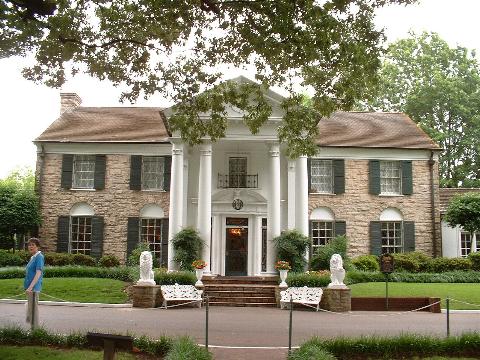 Graceland Memphis, Tennessee |
The next day we headed for Graceland. I always heard Graceland was a super tacky tourist trap so I was expecting the worst but we were both pleasantly surprised. I bought tickets for the package tour about a month before we left to make sure we got the time we wanted. The package tour includes a self-guided tour of the mansion as well as entrance to the Sincerely Elvis Museum, the “Lisa Marie” and “Hound Dog II” jets, the automobile museum and the “Walk a Mile” film. Of course, there are several gift shops there stocked with every conceivable Elvis souvenir. |
The Graceland mansion was a little smaller than we expected and Elvis definitely had eclectic decorating tastes. Some of the rooms looked normal and some rooms were a little strange. The Jungle Room has green shag carpet, a waterfall and various animals scattered about. One hallway had the same green shag carpet on the walls and the ceiling. Only the downstairs of the mansion is open to the public. Elvis is buried in the back yard next to his mother and father near the reflection pool. There is also a small plaque memorializing Elvis' twin brother who was still born. Can you imagine two Elvi?
After lunch at Elvis Presley’s Memphis on Beale Street (the King was everywhere), we went to the National Civil Rights Museum. The museum is housed in the Lorraine Motel, the site of Martin Luther King Jr.’s assassination in 1968. The museum was good but there was almost too much to see and read in the time we had. The museum continued in the building across the street. This building was the boarding house where James Earl Ray supposedly fired the shot from, hitting King while he stood on the balcony of the motel. There is almost as much controversy regarding who really shot King as there is for President Kennedy’s assassination. One theory is that Ray was just the fall guy. We’ll probably never know the truth.
That night, we went back to Beale Street - birthplace of the Blues. Beale Street is a smaller version of the French Quarter in New Orleans except the music of choice is the Blues instead on Jazz. BB King had a large club there. At night, the street is closed to vehicle traffic and you can walk around with your beverage of choice. We bought a couple of “Big Ass beers to go” and watched a good rhythm and blues band playing right on the street.
The next day, Kathy dropped me off at the Convention Center for my show. Kathy would be bored there and she hadn’t been to Arkansas so after dropping me off, she crossed the Mississippi River into Arkansas and headed for Village Creek State Park to do some hiking. We synchronized our watches and decided on a time she would pick me up. I could have spent at least the whole day at the show but I did manage to purchase some notes I have been looking for for a long time.
|
After Kathy picked me up, we headed for Shiloh National Military Park in southeastern Tennessee. I am somewhat of a Civil War buff having visited Gettysburg, Antietam, Vicksburg, Manassas and many other battlefields as well as Confederate museums, a Confederate POW camp in Ohio, Robert E. Lee and Jefferson Davis’ houses, etc. This trip turned into quite a Civil War history lesson as we planned to visit five battlefields. |
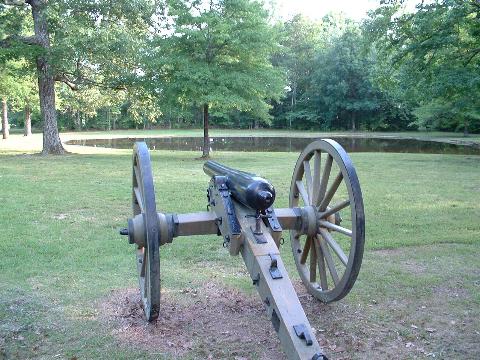 The Bloody Pond Shiloh National Military Park, Tennessee |
Two of my favorite places in Shiloh were the Hornet’s Nest – a road where Union troops tried to hold off the Confederate advance and the Bloody Pond where the wounded and dying of both sides went to quench their thirst. There are many monuments standing throughout the park erected by veterans of the various regiments that fought on both sides. It is hard to imagine the carnage that went on at the battlefields such as Shiloh as they are such quiet, peaceful, beautiful places today. I always try to picture the hardships that the soldiers endured at these places and wonder how they could have fought each other so fiercely when they were really from the same country.
After spending the night in Corinth, Mississippi, we went to Tupelo, Mississippi and saw the house where Elvis was born in. The house is not much bigger than an outhouse and is way smaller than the guesthouse at Graceland. We also saw Tupelo National Battlefield. This was a small battlefield but still interesting.
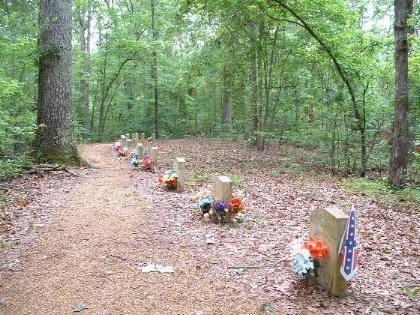 Confederate Graves Natchez Trace Parkway, Tennessee |
From Tupelo, we drove on part of the Natchez Trace Parkway. This Parkway stretches 440 miles from Natchez, Mississippi to just a few miles south of Nashville, Tennessee. It started out as a trail used by the Natchez, Chickasaw and Choctaw Indians. The French knew the trail well enough to map it by 1733. By 1785 Ohio River Valley farmers searching for markets had begun floating their crops and products down the rivers to Natchez or New Orleans. After they sold their flatboats for lumber, they either rode or walked back along the trail. By 1810 the trail became an important wilderness road and by 1820 there were more than 20 inns called stands in operation along the road. |
We watched a film about the Parkway at the Tupelo Visitor Center and then headed north on the Parkway. Along the 55-mile section that we drove, we stopped to hike a short distance on the original trail to a row of 13 unknown Confederate soldier gravesites. We also saw the Pharr Mounds, a 90-acre complex of eight burial mounds built between 1,800 and 2,000 years ago. There are probably a hundred points of interest along the whole Parkway including the Meriwether Lewis Site. In 1809 Lewis who became governor of Louisiana Territory after returning from his famous expedition, was traveling on the trail to Washington D.C. He died from mysterious gunshot wounds thought to have been self-inflicted and is buried at the site. Someday, it would be nice to take a couple of days to travel the whole Parkway.
We left the Natchez Trace Parkway near the Tennessee River and headed east completely crossing Alabama to Fort Oglethorpe, Georgia where we spent the night. The next day, we visited the Chickamauga and Chattanooga National Military Park where the Union and Confederate armies clashed during the fall of 1863 in some of the hardest fighting of the Civil War. There are several different sections of this Military Park scattered around Chattanooga, Tennessee and just across the border in Georgia.
My favorite site of this Military Park was Lookout Mountain Battlefield and Point Park. Lookout Mountain is 500’ high and has a commanding view of the city of Chattanooga, which was a main Confederate rail terminus during the Civil War. We drove to the top but there is also an old train that you can ride to the top. It is one of the steepest railways in the world gradually reaching a 72.7% incline. While we were walking around a residential area at the top, we noticed several trees that were toppled including one that had fallen on a house. Later, when we were taking a tour of the Craven House (taken over by Union troops during the war), we learned that just a few days earlier, they had a huge storm there and a tornado may have caused the damage.
From Chattanooga, we drove to the Great Smoky Mountains National Park located on the Tennessee/North Carolina border. This beautiful National Park is world renowned for the diversity of its plant and animal life and has over nine million visitors annually. It is a hiker’s paradise with over 800 miles of trails. In the park, we hiked a very short distance along the Appalachian Trail, which stretches 2,155 miles from Maine to Georgia. Along the trail, we saw plenty of wild blooming rhododendrons.
After the hike, we drove to the trailhead for Clingmans Dome, at 2,024 m or 6,423’, the tallest mountain in the Park. Even though we were both suffering from a respiratory ailment, we hiked the fairly steep trail to the top of the peak and then to the top of an observation deck. Unfortunately, we were in the fog/clouds and visibility was down to about fifty feet. I could only imagine how spectacular the view must be on a clear day.
By late afternoon, it was time to leave the Smoky Mountains. We ate dinner on the Cherokee Indian Reservation just outside the Park and then drove on to Asheville, North Carolina where we spent the night. We definitely packed a lot into this day!
The next morning, we drove a short distance to the Biltmore Estate. George Vanderbilt built the Biltmore House on the estate from 1889 to 1895. It is built like a French Chateau and is the largest house in the United States. I remember seeing commercials for it on TV while I was stationed in South Carolina in the mid-70’s. We did the self-paced tour of the inside of the house and then walked through some of the huge gardens and grounds.
|
The grounds were completely transformed from farmland to a natural looking forest with a lake and streams by America’s foremost landscape architect, Frederick Law Olmsted. He also designed Central Park in New York City and Belle Isle in Detroit, Michigan. Finally, we stopped by Biltmore Estate Winery for a little wine tasting. The wine was good but not as good as California wine. When we left the winery, the rain was really coming down. |
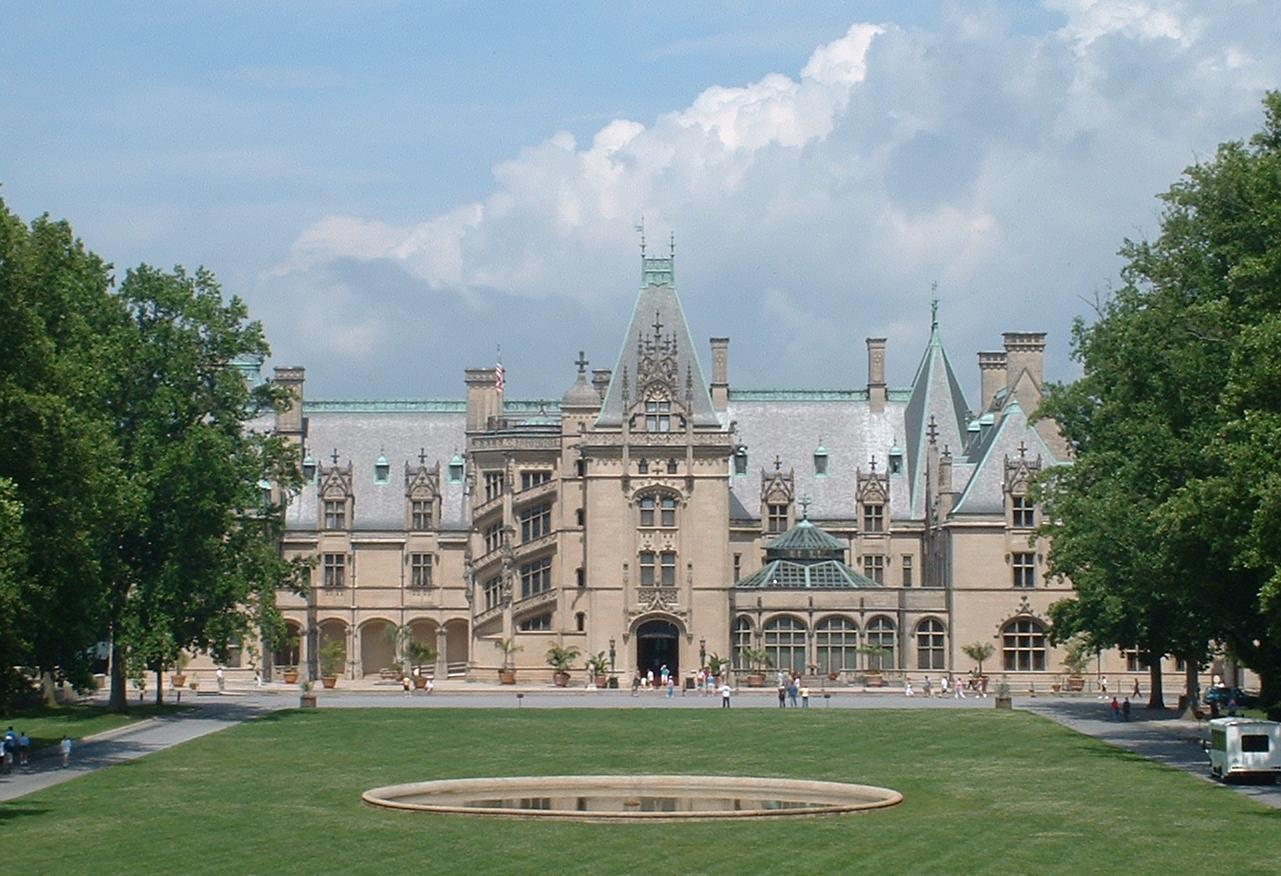 Biltmore House Asheville, North Carolina |
From the Biltmore Estate, we drove back to Nashville where we spent the night. The next day, we drove northwest to Fort Donelson National Battlefield. This battlefield includes different areas around the small town of Dover, Tennessee. Fort Donaldson was built on the Cumberland River to protect the Confederate batteries there from land attack. There are the usual monuments, a National Cemetery and the Dover Hotel built between 1851 and 1853 to accommodate riverboat travelers. This hotel was where the largest surrender of the war took place. 13,000 Confederate soldiers were loaded on to transports to begin their journey to Northern prisoner-of-war camps.
By this time, we learned the people in this neck of the woods (the South) love fireworks. We passed several large fireworks superstores on the highway. In California, you can only buy fireworks in the weeks leading up to July 4th and anything that leaves the ground is illegal including firecrackers. I believe the stores we passed are open year round. It would have been interesting to see what kind of explosive devices they sell.
Our next destination was the Hermitage Plantation and Mansion back in Nashville. The mansion was built between 1819 and 1821 and is where Andrew Jackson lived before and after he was President. It was almost completely rebuilt in 1836 after fire in 1834 did major damage. Touring the mansion was like stepping back in time. I particularly liked the black horsehair furniture.
Jackson and his wife are buried in a tomb not far from the mansion. There are several archeological digs going on around the grounds, which include the first Hermitage – a more modest house where the Jacksons lived from 1804 to 1821, a garden, a smokehouse and reconstructed slave quarters. There is a beautiful magnolia tree located right next to the mansion.
I learned that Andrew Jackson was a very controversial person. He was the hero of the Battle of New Orleans, but he also owned slaves, killed a man in a duel, had a man executed, and almost lost the presidential election because of a scandal. It seems the woman he married was still married to another man. I guess overall, he was/is pretty popular as his portrait graces our twenty-dollar bills.
That night, we had dinner at our favorite road restaurant called Cracker Barrel. After dinner, we saw the Grand Ole Opry show. Although neither of us are great Country & Western music fans, we decided to see the show since the Grand Ole Opry is such an American landmark.
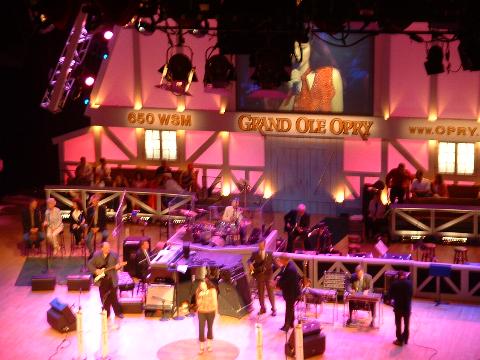 Grand Ole Opry Nashville, Tennessee |
Back in 1974 the Grand Ole Opry moved from its downtown location at the Ryman Auditorium (a former church built in 1892) to a beautiful new auditorium in the suburbs of Nashville. The show itself is actually a 2.5-hour live radio broadcast. It's the longest-running continuous radio broadcast in the U.S. and has not missed a broadcast since its beginning in 1925. |
The show we saw had eight acts each playing for about 15 minutes and in between acts, the announcer would do a live commercial. The performers we saw were Porter Wagoner, Mandy Barnett, Riders in the Sky, Jean Shepherd, Bill Anderson, Little Jimmy Dickens and two others whose names I can’t recall.
One place near the new Grand Ole Opry House that we passed and I learned later would have been worth checking out is the Gaylord Opryland Resort. It is a huge hotel/resort that features three interior garden spaces under glass roofs: The Conservatory is a botanical garden with more than 10,000 tropical plants; the Cascades is a lushly planted area with a waterfall and fountain; and the Delta covers 4.5 acres and is highlighted by a river and lake system with passenger-carrying flatboats.
The next day we drove south from Nashville to the town of Murfreesboro to see our fifth and final battlefield on this trip: Stones River National Battlefield. This battlefield contains numerous monuments, a National Cemetery, several buildings and you can still see part of the original 14,000’ of earthworks that protected Fortress Rosecrans. While we were hiking on one of the trails, I spotted a cardinal, my favorite North American bird.
After touring the battlefield, we drove back to Nashville, seeing the downtown area. We toured the State Capitol Building, a fine example of Greek Revival architecture, built in 1859, the Ryman Auditorium and finally, we walked along Broadway where some of the ‘World Famous” bars are located. From there, we drove to the airport and flew back home to California.
We drove 1,700 miles on this trip. It rained a few times but mostly when we were driving and it never stopped us from hiking or seeing the Civil War battlefields. Once again, we packed a month of sightseeing into a week but it was worth it!
|
Music: Dixie Tennessee Waltz It's Now or Never |
 |